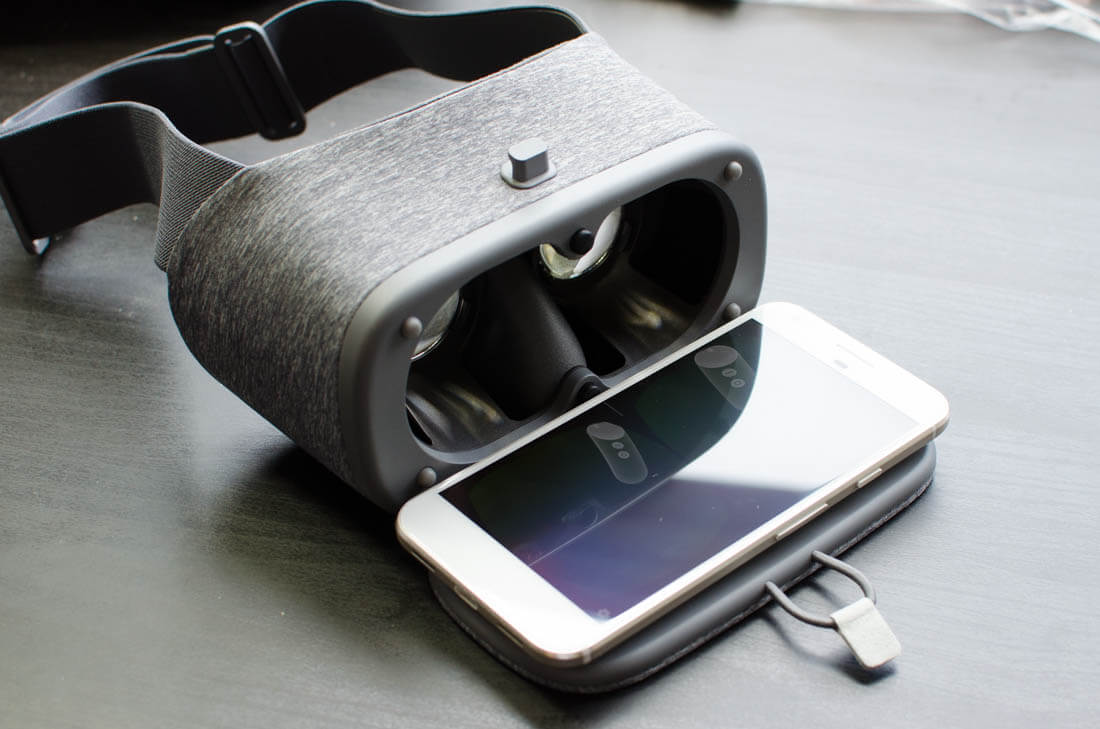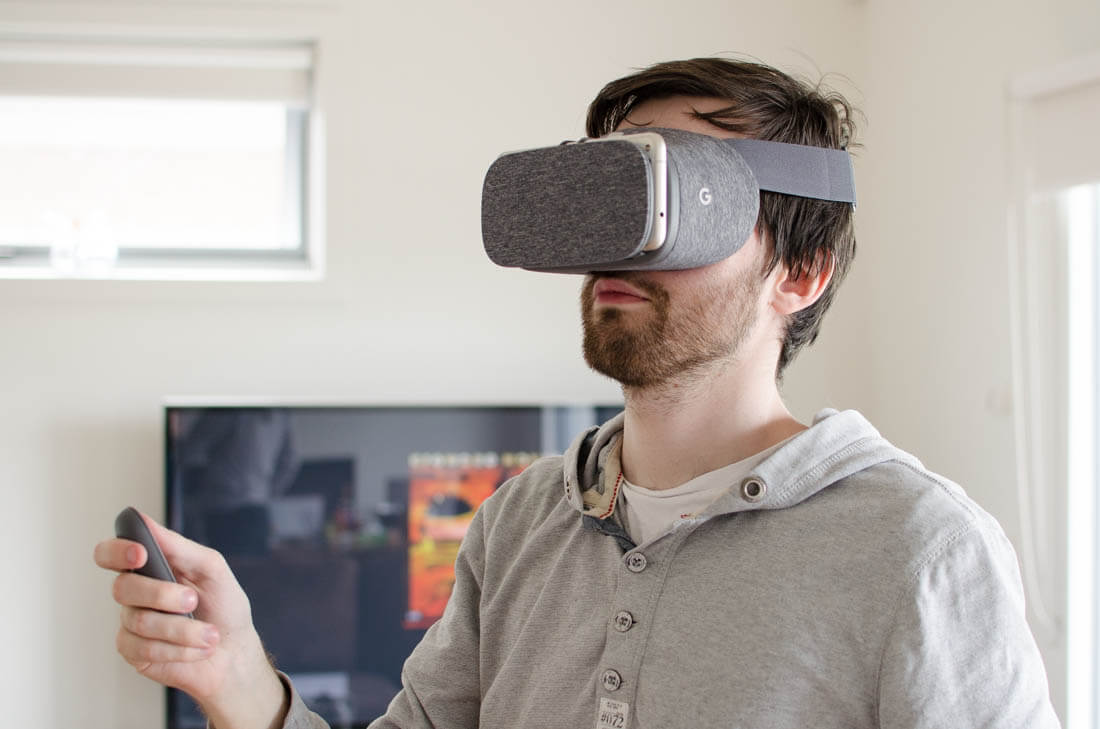Virtual reality powered by smartphones is an awesome concept. While tethered VR systems like the HTC Vive and Oculus Rift require expensive headsets and even more expensive gaming PCs, mobile VR requires just a cheap addition to something most people already have: a smartphone.
We've already seen several solutions for mobile VR, most notably Samsung's Gear VR, which only works with high-end Samsung devices; and Google Cardboard, which is a cheap and limited option available to anyone. But Google is taking things to the next level with Daydream: a new virtual reality ecosystem for Android and the most compelling case for accessible VR I've seen to date.
I've spent the last few days with Daydream and Google's corresponding headset, the Daydream View, to check out the ecosystem ahead of its launch. In short, it's very impressive, and those with a supported smartphone should strongly consider purchasing the $79 Daydream View headset when they go on sale today.
Let's get some of the basics out of the way. Daydream is virtual reality platform announced at Google I/O 2016 that consists of several APIs and a launcher application. Support for Daydream is built into Android 7.1, however you'll need a "Daydream-Ready" device to access the ecosystem. Due to specific software and hardware requirements for Daydream, the Google Pixel and Pixel XL are the only phones that currently support the platform, although you can expect to see many more compatible devices hit the market in coming months.

It's worth mentioning two additional things here. Daydream won't be available on older devices due to stringent hardware requirements, including low-latency displays and current-generation processors (such as the Qualcomm Snapdragon 821). Daydream will also require a high-end smartphone, so don't expect to see budget products that are "Daydream-Ready".
For now, if you want to use Daydream you'll need to purchase a Daydream View headset, which is a pretty great piece of hardware. Built from plastic but mostly covered with a layer of soft fabric, the Daydream View feels excellent and looks quite nice. It's lighter and much smaller than the Gear VR, which makes it more portable, and the single-band head strap is far less complicated.

To use the Daydream View, all you need to do is insert a Pixel or Pixel XL into the holder, which opens like an airplane tray table when you release the elastic strap that holds it closed. The entire set-up process is much easier than the Gear VR as there are no awkward holding clasps and no plugs to attach; the Pixel instead recognizes the Daydream View through NFC and automatically launches the Daydream app when you insert it into the headset.
The controller is the reason Daydream is so much more compelling than Gear VR or any other mobile VR solution I've tried. It's genuinely a game changer.
While it can be somewhat fiddly to position the Daydream View in the optimum spot, the headset is extremely comfortable to wear. Copious amounts of soft foam provide plenty of comfort, and the large nose hole will be perfect for most people. I found it much more comfortable than the Gear VR, which has a more rigid body with less foam, and I had no issues with sweat or fatigue after a lengthy VR session.
The one downside to the Daydream View is that it leaks too much light from the sides of the headset in comparison to the Gear VR, which can introduce the occasional lens flare in a brightly lit room. The Gear VR also has a marginally larger field of view, which assists with immersion.

By far the best aspect of the entire Daydream package is the controller. The plastic design looks basic from the outside, but on the inside there's a collection of sensors that allows the controller to act like a motion-tracked wand. The interface of Daydream has you aiming the controller like a laser pointer to select items, and for something that doesn't rely on external cameras or tracking devices, the whole system works much more seamlessly than I expected.
These motion controls are combined with a trackpad and three buttons - select, menu, and home - to form the basis of Daydream's control system. It's easy to use, intuitive, and just damn awesome. Navigation feels far, far more natural than the awkward headset-mounted control pad on the Gear VR, and natural interface systems are always the easiest to use. With Daydream, all you need to do is point and click for the most part.
The controller is a key aspect of most Daydream VR applications, and facilitates a whole range of interactivity and gameplay options. In one game I tried, the controller is used to point at targets you want to shoot, while the trackpad is used to move the playable character around the scene. In another game, I used the controller as a golf club for a round of mini-golf. In Google Street View, you use the controller like a laser pointer to designate where you want to move. All of these control systems were easy to grasp and fluid to use.

Google has also designed the three buttons in such a way that you can easily find them by touch only, as you can't see the controller itself in the world of VR. The home button is concave, while the menu button features a raised ridge, and this is enough to distinguish what you're pressing without much effort.
The controller is the reason Daydream is so much more compelling than Gear VR or any other mobile VR solution I've tried. It's genuinely a game changer.
To be clear, the single controller that comes with Daydream VR is not as versatile as the controllers you get with the Vive or Rift. It's an effective and accurate pointer, but it lacks spatial recognition, so you can't use it to reach out and grab an in-world item, for example. However, for a portable VR system that requires basically no setup, the control system is versatile and just makes sense.
As Daydream VR is powered by a smartphone, it's worth discussing how it performs. Throughout the apps and games I tested, I ran into surprisingly few issues with frame rate and movement tracking. For the most part, the Pixel XL maintained a high frame rate and tracked my head with near-perfect precision, which led to a motion-sickness-free experience. In comparison, the Gear VR with a Galaxy S6 performs well, however tracking seemed to stutter at times on Samsung's solution where it didn't in Daydream.

I was also able to use Daydream on the Pixel XL for longer than I could on the Gear VR. Samsung's smartphones tend to throttle significantly after 10 minutes of heavy graphics workloads, whereas the Pixel XL can sustain its performance for longer. The phone does get very hot in the headset during operation, but it takes 30 to 40 minutes of heavy gaming before slowdowns begin to appear.
In an ideal world, Daydream devices wouldn't slow down at all, even during lengthy periods of use. However, it's hard to develop a high-end product that can sustain top-end performance for hours without running into thermal limits, and I'm quite content with the amount of time you can use Daydream in one sitting. I expect this to improve over time as well, as companies develop new hardware solutions to tackle throttling in VR environments.

The most lacklustre aspect to Daydream is the collection of content at launch. There are only 10 apps available today, although Google promises a wide variety of content (another 41 apps) will be available before the end of the year. I've tried all the apps available at launch, and while most are polished and well made, I feel as though the best stuff is yet to be released.
The best app I've tried on Daydream was Star Chart VR, a $4.99 app that lets you explore the planets and moons in our solar system. I'm a big sucker for astronomy and space exploration, and the experience of floating around in space while zooming billions of kilometres to different planets was a lot of fun. The app gives a great sense of just how vast our solar system is, and it's packed with loads of information not just on planets, but stars and constellations.

This is Wonderglade, a Daydream launch title
I enjoyed playing Wonderglade (free with in-app purchases) briefly, which is a fun park game designed for children. The set of min-games within Wonderglade make great use of the controller, but the depth of content is limited. Mekorama ($3.99) is another game I played briefly that uses clever 3D puzzle mechanics, but it's probably not something I'd play for hours in Daydream when it works well as a standard mobile game.
Rounding out the collection of launch games is Hunters Gate ($5.99), which is another that makes great use of the controller. However, the actual game itself felt shallow and repetitive after an hour or so of gameplay, and while its decent graphics gives me hope for other mobile-powered VR games, I probably wouldn't recommend it.

This is VR Karts, which is not available at launch
The Wall Street Journal app includes a compelling stock visualization tool, but I'm not sure who would use Daydream to view stocks or read the news. The Google Arts & Culture app has plenty of artworks and content from museums, though it's another app that doesn't add much by being in VR. The best two VR apps designed by Google are YouTube and Street View, as they're packed with content and work well with some Daydream-specific enhancements.
What I'm more excited about are upcoming apps like the Fantastic Beasts experience, LEGO Mekorama, VR Karts, Need for Speed: No Limits VR, Netflix and more, which are all set for launch later this year. From what I've seen in preview videos, those apps could seriously bring the Daydream platform to life.

Finally, I was impressed with Google's Daydream launcher application, which is simple to navigate and provides quick access to content through the remote. The integrated Play Store is easy to use, although it might require some discoverability tweaks as more content is added. The tutorial section is fantastic as well, and guides you through all the basics of Daydream with plenty of interactivity.
Shopping shortcuts:
After a few days with Daydream, it's clear that Google has put a lot of work into creating the most compelling Android VR solution. The controller is amazing and the Daydream View headset is comfortable and affordable. While the selection of content isn't fantastic right now, there's plenty of stuff to look forward to, and it won't be long before Gear VR and other competitors fade into the distance.